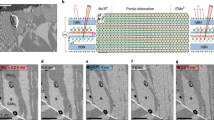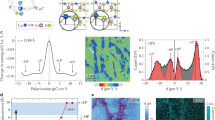Abstract
Precise control of the conductivity of layered ferroelectric semiconductors is required to make these materials suitable for advanced transistor, memory and logic circuits. Although proof-of-principle devices based on layered ferroelectrics have been demonstrated, it remains unclear how the polarization inversion induces conductivity changes. Therefore, function design and performance optimization remain cumbersome. Here we combine ab initio calculations with transport experiments to unveil the mechanism underlying the polarization-dependent conductivity in ferroelectric channel field-effect transistors. We find that the built-in electric field gives rise to an asymmetric conducting route formed by the hidden Stark effect and competes with the potential redistribution caused by the external field of the gate. Furthermore, leveraging our mechanistic findings, we control the conductivity threshold in α-In2Se3 ferroelectric channel field-effect transistors. We demonstrate logic-in-memory functionality through the implementation of electrically self-switchable primary (AND, OR) and composite (XOR, NOR, NAND) logic gates. Our work provides mechanistic insights into conductivity modulation in a broad class of layered ferroelectrics, providing foundations for their application in logic and memory electronics.
This is a preview of subscription content, access via your institution
Access options
Access Nature and 54 other Nature Portfolio journals
Get Nature+, our best-value online-access subscription
$29.99 / 30 days
cancel any time
Subscribe to this journal
Receive 12 print issues and online access
$259.00 per year
only $21.58 per issue
Buy this article
- Purchase on Springer Link
- Instant access to full article PDF
Prices may be subject to local taxes which are calculated during checkout





Similar content being viewed by others
Data availability
The data that support the findings of this study are available from the corresponding authors upon reasonable request. Source data are provided with this paper.
References
Wang, S. et al. Two-dimensional devices and integration towards the silicon lines. Nat. Mater. 21, 1225–1239 (2022).
Ding, W. et al. Prediction of intrinsic two-dimensional ferroelectrics in In2Se3 and other III2–VI3 van der Waals materials. Nat. Commun. 8, 14956 (2017).
Zhou, Y. et al. Out-of-plane piezoelectricity and ferroelectricity in layered α-In2Se3 nanoflakes. Nano Lett. 17, 5508–5513 (2017).
Li, Q. et al. Optoelectronic and ionic effects on transport in van der Waals metal selenophosphate AgBiP2Se6. Phys. Rev. Appl. 19, 054055 (2023).
Shang, J. et al. Stacking-dependent interlayer ferroelectric coupling and moiré domains in a twisted AgBiP2Se6 bilayer. J. Phys. Chem. Lett. 13, 2027–2032 (2022).
Liao, J. et al. Van der Waals ferroelectric semiconductor field effect transistor for in-memory computing. ACS Nano 17, 6095–6102 (2023).
Sui, F. et al. Sliding ferroelectricity in van der Waals layered γ-InSe semiconductor. Nat. Commun. 14, 36 (2023).
Wu, M. & Zeng, X. C. Bismuth oxychalcogenides: a new class of ferroelectric/ferroelastic materials with ultra high mobility. Nano Lett. 17, 6309–6314 (2017).
Tan, C. et al. 2D fin field-effect transistors integrated with epitaxial high-k gate oxide. Nature 616, 66–72 (2023).
Wang, W. et al. Electrically switchable polarization in Bi2O2Se ferroelectric semiconductors. Adv. Mater. 35, 2210854 (2023).
Wang, S. et al. Two-dimensional ferroelectric channel transistors integrating ultra-fast memory and neural computing. Nat. Commun. 12, 53 (2021).
Xue, F. et al. Giant ferroelectric resistance switching controlled by a modulatory terminal for low-power neuromorphic in-memory computing. Adv. Mater. 33, 2008709 (2021).
Yang, H. et al. Nonvolatile memristor based on heterostructure of 2D room-temperature ferroelectric α-In2Se3 and WSe2. Sci. China Inf. Sci. 62, 220404 (2019).
Si, M. et al. A novel scalable energy-efficient synaptic device: crossbar ferroelectric semiconductor junction. In IEEE International Electron Devices Meeting (IEDM), 6.6.1–6.6.4 (2019).
Si, M. et al. A ferroelectric semiconductor field-effect transistor. Nat. Electron. 2, 580–586 (2019).
Wang, J. et al. Logic and in-memory computing achieved in a single ferroelectric semiconductor transistor. Sci. Bull. 66, 2288–2296 (2021).
Wang, L. et al. Exploring ferroelectric switching in α-In2Se3 for neuromorphic computing. Adv. Funct. Mater. 30, 2004609 (2020).
Liu, K. et al. An optoelectronic synapse based on α-In2Se3 with controllable temporal dynamics for multimode and multiscale reservoir computing. Nat. Electron. 5, 761–773 (2022).
Wang, S., Liu, X. & Zhou, P. The road for 2D semiconductors in the silicon age. Adv. Mater. 34, 2106886 (2022).
Sun, Y., Wang, S., Chen, X., Zhang, Z. & Zhou, P. Multioperation mode ferroelectric channel devices for memory and computation. Adv. Intell. Syst. 4, 2100198 (2022).
Rodriguez, J. R. et al. Electric field induced metallic behavior in thin crystals of ferroelectric α-In2Se3. Appl. Phys. Lett. https://doi.org/10.1063/5.0014945 (2020).
He, J., Stephenson, G. & Nakhmanson, S. Electronic surface compensation of polarization in PbTiO3 films. J. Appl. Phys. 112, 054112 (2012).
Fredrickson, K. D. & Demkov, A. A. Switchable conductivity at the ferroelectric interface: nonpolar oxides. Phys. Rev. B 91, 115126 (2015).
Quindeau, A. et al. Origin of tunnel electroresistance effect in PbTiO3-based multiferroic tunnel junctions. Phys. Rev. B 92, 035130 (2015).
Radaelli, G. et al. Large room-temperature electroresistance in dual-modulated ferroelectric tunnel barriers. Adv. Mater. 27, 2602–2607 (2015).
Liu, X., Tsymbal, E. Y. & Rabe, K. M. Polarization-controlled modulation doping of a ferroelectric from first principles. Phys. Rev. B 97, 094107 (2018).
Kim, J. et al. Observation of tunable band gap and anisotropic Dirac semimetal state in black phosphorus. Science 349, 723–726 (2015).
Lu, X. & Yang, L. Stark effect of doped two-dimensional transition metal dichalcogenides. Appl. Phys. Lett. 111, 193104 (2017).
Li, C. et al. Band structure, ferroelectric instability, and spin–orbital coupling effect of bilayer α-In2Se3. J. Appl. Phys. 128, 234106 (2020).
Kim, W. Y. et al. Graphene–ferroelectric metadevices for nonvolatile memory and reconfigurable logic-gate operations. Nat. Commun. 7, 10429 (2016).
Shuai, W.-J., Wang, R. & Zhao, J.-Z. Ferroelectric phase transition driven by anharmonic lattice mode coupling in two-dimensional monolayer In2Se3. Phys. Rev. B 107, 155427 (2023).
Wu, J. et al. High tunnelling electroresistance in a ferroelectric van der Waals heterojunction via giant barrier height modulation. Nat. Electron. 3, 466–472 (2020).
Su, Y. et al. Van der Waals multiferroic tunnel junctions. Nano Lett. 21, 175–181 (2021).
Ding, J., Shao, D.-F., Li, M., Wen, L.-W. & Tsymbal, E. Y. Two-dimensional antiferroelectric tunnel junction. Phys. Rev. Lett. 126, 057601 (2021).
Lv, B. et al. Layer-dependent ferroelectricity in 2H-stacked few-layer α-In2Se3. Mater. Horiz. 8, 1472–1480 (2021).
Wan, S. et al. Room-temperature ferroelectricity and a switchable diode effect in two-dimensional α-In2Se3 thin layers. Nanoscale 10, 14885–14892 (2018).
Smidstrup, S. et al. QuantumATK: an integrated platform of electronic and atomic-scale modelling tools. J. Phys. Condens. Matter 32, 015901 (2020).
Perdew, J. P., Burke, K. & Ernzerhof, M. Generalized gradient approximation made simple. Phys. Rev. Lett. 77, 3865–3868 (1996).
Kleinman, L. & Bylander, D. M. Efficacious form for model pseudopotentials. Phys. Rev. Lett. 48, 1425–1428 (1982).
Monkhorst, H. J. & Pack, J. D. Special point for Brillouin-zone integrations. Phys. Lett. B 13, 5188–5192 (1976).
Heyd, J., Scuseria, G. E. & Ernzerhof, M. Hybrid functionals based on a screened Coulomb potential. J. Chem. Phys. 118, 8207–8215 (2003).
Ferreira, L. G., Marques, M. & Teles, L. K. Slater half-occupation technique revisited: the LDA-1/2 and GGA-1/2 approaches for atomic ionization energies and band gaps in semiconductors. AIP Adv. 1, 032119 (2011).
Grimme, S., Antony, J., Ehrlich, S. & Krieg, H. A consistent and accurate ab initio parametrization of density functional dispersion correction (DFT-D) for the 94 elements H–Pu. J. Chem. Phys. 132, 154104 (2010).
Grimme, S., Ehrlich, S. & Goerigk, L. Effect of the damping function in dispersion corrected density functional theory. J. Comput. Chem. 32, 1456–1465 (2011).
Datta, S. (ed.) Cambridge Studies in Semiconductor Physics and Microelectronic Engineering (Cambridge Univ. Press, 1995).
Laturia, A., Van de Put, M. L. & Vandenberghe, W. G. Dielectric properties of hexagonal boron nitride and transition metal dichalcogenides: from monolayer to bulk. NPK 2D Mater. Appl. 2, 6 (2018).
Wang, L., Pu, Y., Soh, A. K., Shi, Y. & Liu, S. Layers dependent dielectric properties of two dimensional hexagonal boron nitride nanosheets. AIP Adv. 6, 125126 (2016).
Acknowledgements
This work was supported by the National Key Research and Development Program of China (2021YFA1200500 (P.Z.)), the National Natural Science Foundation of China (12374025 (R.Q.), 61925402, 62090032 (P.Z.) and 62304042 (S.W.)), the Fund of State Key Laboratory of Information Photonics and Optical Communications (Beijing University of Posts and Telecommunications) (R.Q.), Science and Technology Commission of Shanghai Municipality (19JC1416600 (P.Z.)), the China Postdoctoral Science Foundation (2022M720032 (S.W.)), the Shanghai Post-Doctoral Excellence Program (2022091) and Sailing Program (23YF1402100) (S.W.)), and the High-Performance Computing Platform of BUPT.
Author information
Authors and Affiliations
Contributions
S.W. and P.Z. conceived the idea and supervised the work. R.Q., S.W. and Z.D. co-wrote the manuscript. R.Q. and Y.G. performed the calculations. Z.D. and S.W. fabricated devices for electronic measurements, conducted the experiments and analysed the data. J.Z., Y.S. and L.Z. analysed the data and discussed the manuscript.
Corresponding authors
Ethics declarations
Competing interests
The authors declare no competing interests.
Peer review
Peer review information
Nature Nanotechnology thanks Yen-Fu Lin, Geunsik Lee and the other, anonymous, reviewer(s) for their contribution to the peer review of this work.
Additional information
Publisher’s note Springer Nature remains neutral with regard to jurisdictional claims in published maps and institutional affiliations.
Supplementary information
Supplementary Information
Supplementary sections 1–17 containing Figs. 1–20 and corresponding discussions.
Source data
Source Data Fig. 1
source data of Figure 1
Source Data Fig. 2
source data of Figure 2
Source Data Fig. 3
source data of Figure 3
Source Data Fig. 4
source data of Figure 4
Source Data Fig. 5
source data of Figure 5
Rights and permissions
Springer Nature or its licensor (e.g. a society or other partner) holds exclusive rights to this article under a publishing agreement with the author(s) or other rightsholder(s); author self-archiving of the accepted manuscript version of this article is solely governed by the terms of such publishing agreement and applicable law.
About this article
Cite this article
Quhe, R., Di, Z., Zhang, J. et al. Asymmetric conducting route and potential redistribution determine the polarization-dependent conductivity in layered ferroelectrics. Nat. Nanotechnol. 19, 173–180 (2024). https://doi.org/10.1038/s41565-023-01539-4
Received:
Accepted:
Published:
Issue Date:
DOI: https://doi.org/10.1038/s41565-023-01539-4



